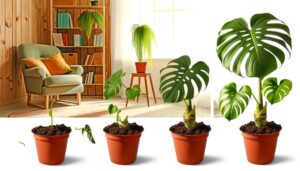Where Monstera Deliciosa Pops up in History
You'll find Monstera deliciosa woven into history, beginning with indigenous cultures that valued its edible fruits and medicinal properties. European explorers discovered it in Central and South America, sparking botanical interest and collection.
During the Victorian era, Monstera became a prized houseplant for its unique fenestrated leaves. Its popularity skyrocketed in the 20th century as an easy-care, aesthetically pleasing houseplant.
Botanists and horticulturists also study its unique morphology and evolutionary adaptations. Today, its commercial value in horticulture and interior design reflects its longstanding charm.
To uncover more about its enchanting journey through history, continue your exploration.

Key Takeaways
- Indigenous cultures, including the Mayans, used Monstera deliciosa for its edible fruits and medicinal properties.
- European explorers discovered Monstera deliciosa in Central and South America, leading to its botanical classification.
- The Victorian era prized Monstera deliciosa for its exotic fenestrated leaves, thriving in glasshouses and Wardian cases.
- Monstera deliciosa became a popular houseplant in the 20th century, known for its striking foliage and ease of care.
- The plant's aesthetic appeal and low maintenance have fueled its global popularity in the modern houseplant market.
Indigenous Uses
Monstera deliciosa, often revered by indigenous cultures, has been traditionally utilized for its edible fruits and medicinal properties. You'll find its fruits, known as 'Mexican breadfruit,' rich in vitamins C and B, making them a valuable nutritional resource. The fruit's unique flavor, combining pineapple and banana notes, is a delicacy in many indigenous diets.
Additionally, the plant's roots and leaves have been used in traditional remedies. By preparing poultices from the leaves, you can treat insect bites and inflammation. The roots, when boiled, help alleviate arthritis symptoms. Indigenous knowledge showcases how Monstera deliciosa isn't just ornamental but an essential part of their holistic health practices, highlighting the intricate relationship between nature and human well-being.
Discovery by Europeans
European explorers first encountered Monstera deliciosa during their expeditions in the tropical regions of Central and South America, marveling at its striking appearance and unusual fruit. You can imagine their fascination upon seeing the plant's large, fenestrated leaves and tasting its unique, pineapple-like fruit. They quickly documented the species, intrigued by its aerial roots, which clung to trees and helped the plant climb towards sunlight.
To summarize key aspects:
| Feature | Description |
|---|---|
| Leaves | Large, fenestrated (split and perforated) |
| Fruit | Pineapple-like taste, hexagonal scales |
| Aerial Roots | Climbing mechanism, attaches to trees |
These explorers collected specimens, contributing to botanical knowledge and facilitating Monstera's introduction to Europe. Their detailed records played an essential role in the plant's scientific classification and study.
Colonial Botanical Gardens
Colonial botanical gardens, established by European powers in their overseas territories, played an important role in the study and cultivation of exotic plants like Monstera deliciosa. These gardens, often located in tropical climates, served as research hubs where botanists meticulously documented plant characteristics.
You'll find that Monstera deliciosa, with its striking fenestrated leaves and unique climbing habit, captured the attention of scientists interested to understand its growth patterns and reproductive biology.
In these gardens, the plant thrived under careful observation, contributing to botanical knowledge and horticultural practices. As a living specimen, Monstera deliciosa provided insights into tropical ecosystems, aiding in the development of classification systems.
This era marked the beginning of its journey from wild jungles to domesticated spaces, laying the groundwork for its global popularity.
Victorian Plant Craze
During the Victorian era, the passion for exotic plants skyrocketed, with enthusiasts keenly seeking out rare specimens to cultivate in their homes and conservatories. You'd find Monstera deliciosa among these prized collections. Its unique fenestrated leaves and robust growth habit made it a standout choice.
Victorian gardeners employed Wardian cases—miniature greenhouses—to transport and nurture these tropical plants. The era's horticultural fervor was fueled by advancements in botany and global exploration, which introduced exotic species to Europe. Monstera deliciosa, native to Central America, thrived in the controlled humidity of Victorian glasshouses.
This period marked a pivotal moment in plant cultivation, blending scientific discovery with aesthetic enjoyment, and solidifying the Monstera's status as a botanical marvel.
20th Century Houseplant Boom
The mid-20th century saw a dramatic surge in the popularity of houseplants, with Monstera deliciosa emerging as a favorite due to its striking foliage and ease of care.
You'd be captivated by its large, glossy leaves, which develop unique fenestrations—a natural adaptation to tropical environments allowing light to filter through the canopy.
The plant thrives in indirect sunlight and tolerates a range of indoor conditions, making it an ideal choice for urban dwellers. Monstera deliciosa's aerial roots help it climb and anchor, mimicking its natural rainforest habitat.
Its robust nature and minimal care requirements contributed to its widespread adoption during this period, solidifying its status as an iconic mid-century houseplant.
Pop Culture Appearances
You'll notice Monstera deliciosa's broad, fenestrated leaves in numerous iconic film scenes, adding a touch of lushness to set designs.
This plant also features prominently in influential music videos, symbolizing both urban sophistication and natural beauty.
Additionally, its distinctive leaf patterns have inspired trends in fashion and interior design, reflecting its broad cultural impact.
Iconic Film Cameos
Several iconic films have featured the Monstera deliciosa, showcasing its distinctive fenestrated leaves as a symbol of exotic allure and botanical elegance.
In the 1972 film 'The Godfather,' you'll spot its lush greenery subtly enhancing the opulence of the Corleone household. The glossy, perforated leaves create an ambiance that's both sophisticated and mysterious.
Similarly, in 'Scarface' (1983), the Monstera deliciosa's presence underscores the luxurious, yet dangerous, lifestyle of Tony Montana. Its large, split leaves reflect the tension between nature and human ambition.
These deliberate placements highlight the plant's cultural resonance, drawing on its scientific qualities—like its natural adaptability and striking morphology—to enrich cinematic storytelling. You'll appreciate how filmmakers use this plant to deepen visual narratives.
Influential Music Videos
In the world of influential music videos, Monstera deliciosa's striking foliage often acts as a visual metaphor for exoticism and allure, enhancing both the aesthetic and emotional depth of the scenes. You'll find its large, fenestrated leaves creating a lush, tropical atmosphere that resonates with themes of mystery and sensuality.
Directors use this plant to evoke a sense of untamed nature, contrasting with human vulnerability or sophistication. The Monstera's unique morphology, with its perforated leaves, symbolizes complexity and growth.
In videos like Beyoncé's “Hold Up” or Rihanna's “What Now,” its presence isn't just decorative; it amplifies the narrative, signifying hidden layers and emotional intricacies that mirror the artists' performances and lyrics.
Fashion and Design Trends
Just as Monstera deliciosa's lush leaves heighten the visual storytelling in music videos, they also infiltrate fashion and design trends, appearing on everything from high-end textiles to bespoke wallpaper, embodying a blend of nature's complexity and modern sophistication.
You've likely seen its iconic, fenestrated foliage on patterned dresses or statement home décor items. Designers capitalize on the plant's intricate leaf structure to convey both organic elegance and contemporary style.
To enjoy Monstera trends:
- Fashion: Seek out dresses and accessories featuring Monstera prints for a chic, botanical look.
- Home Décor: Invest in Monstera-themed wallpapers or throw pillows to add a touch of nature indoors.
- Art: Look for contemporary art pieces that incorporate Monstera leaves for a stylish aesthetic.
Modern Interior Design
Monstera deliciosa has become a staple in modern interior design due to its unique fenestrated leaves and ability to thrive in low-light conditions. You'll find its large, perforated leaves adding a touch of nature's elegance to living spaces.
This plant's adaptability to indoor environments makes it perfect for urban dwellings where natural light is limited. Its aerial roots also contribute to its structural uniqueness, allowing it to absorb moisture and nutrients from the air.
When you incorporate Monstera into your home, you're not just adding decoration but also improving air quality through its natural ability to filter airborne toxins. This makes Monstera a functional and aesthetic choice for contemporary interiors, blending seamlessly with various decor styles.
Medicinal Applications
Surprisingly, did you know that Monstera deliciosa has been explored for its potential medicinal properties, particularly in traditional medicine systems? This plant isn't just a decorative piece; it's been utilized for various health benefits. Here are three notable applications:
- Anti-inflammatory: Monstera deliciosa extracts have been used to alleviate inflammation, thanks to bioactive compounds that reduce swelling and redness.
- Wound healing: Traditional healers have applied its leaves to wounds to promote faster healing, leveraging its antimicrobial properties.
- Digestive aid: The fruit of Monstera deliciosa, when ripe, has been consumed to aid digestion, providing relief from constipation and other gastrointestinal issues.
Such uses underscore the plant's multifaceted role, extending beyond aesthetics to potentially valuable health applications.
Symbolism in Art
In art, Monstera deliciosa often symbolizes growth, significance, and the intricate beauty of nature, capturing the viewer's imagination through its distinctive fenestrated leaves. These unique perforations aren't just visually striking; they scientifically enhance light capture and water distribution, reinforcing the plant's resilience and adaptability.
Artists leverage this botanical marvel to convey themes of evolution and survival. When you see Monstera in paintings or sculptures, it often represents the harmonious blend of form and function. The plant's lush green foliage evokes a sense of energy and renewal, making it a popular motif in contemporary and classical art.
Conservation Efforts
You'll find that conservation efforts for Monstera deliciosa focus on preservation initiatives, such as controlled cultivation and legal protections.
To address habitat restoration, scientists employ reforestation techniques to rebuild native ecosystems.
Understanding the threats and solutions involves analyzing environmental impacts, invasive species, and climate change adaptations.
Preservation Initiatives
Numerous organizations worldwide have launched initiatives to conserve Monstera deliciosa, focusing on habitat preservation and sustainable cultivation practices. You'll find that these efforts aim to protect this iconic species from threats like deforestation and over-harvesting.
Here are three key initiatives:
- Seed Bank Programs: These programs store seeds under controlled conditions, ensuring genetic diversity and future replanting options.
- Sustainable Farming Practices: Encouraging farmers to use eco-friendly methods reduces the environmental impact of cultivation.
- Legal Protection: Enacting laws to protect Monstera deliciosa in its native habitat helps mitigate illegal collection and trade.
Habitat Restoration
Building on the preservation initiatives, habitat restoration plays a crucial role in guaranteeing Monstera deliciosa thrives in its natural habitat.
You'll focus on replanting native flora, controlling invasive species, and maintaining the delicate balance of the ecosystem. By restoring degraded areas, you create conditions where Monstera can flourish, promoting biodiversity and ecological stability.
Utilizing scientific methods, such as soil analysis and hydrological assessments, guarantees that habitats are restored accurately and sustainably. Additionally, collaborating with local communities and conservation groups fosters a shared commitment to preserving these essential ecosystems.
Your efforts directly contribute to the resurgence of Monstera deliciosa populations, ensuring their continued presence and ecological function within tropical forests.
Threats and Solutions
In recent years, Monstera deliciosa faces significant threats from habitat loss, climate change, and illegal trade, necessitating targeted conservation efforts. You need to understand these threats to appreciate the urgency of conservation.
Habitat destruction from deforestation reduces the natural environment where Monstera thrives. Climate change alters precipitation patterns, affecting its growth cycles. Illegal trade not only depletes wild populations but also disrupts local ecosystems.
To combat these issues, consider the following strategies:
- Habitat Protection: Support initiatives aimed at preserving rainforests.
- Climate Action: Reduce carbon footprints to mitigate climate change impacts.
- Sustainable Trade: Purchase Monstera from certified, ethical suppliers.
Conclusion
You've journeyed through the fascinating history of Monstera deliciosa. One striking statistic? In the 1970s, over 90% of U.S. households owned at least one houseplant, with Monstera deliciosa being a top favorite.
This trend showcases its enduring popularity, from ancient indigenous uses to modern interior design. As you admire this plant's iconic, perforated leaves, remember its rich past and the scientific curiosity it still sparks today.
Your home's not just greener; it's historically enriched.






